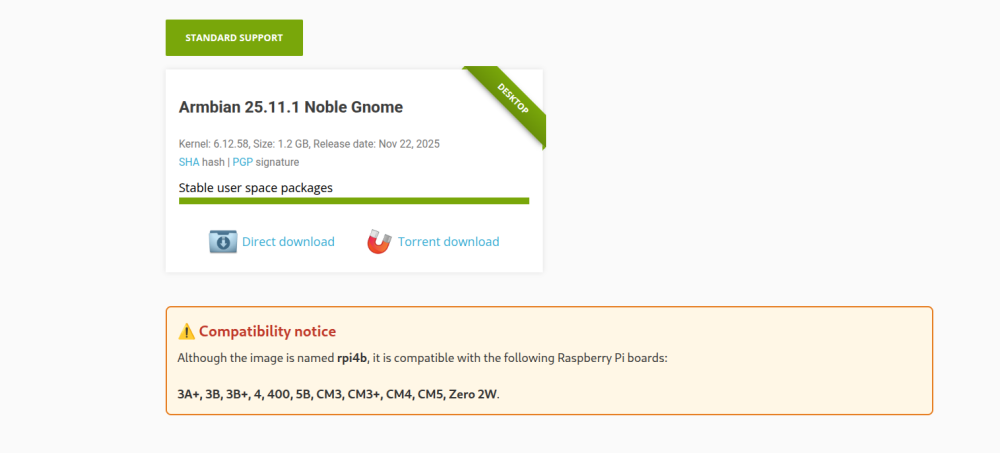-
Posts
14574 -
Joined
-
Last visited
Content Type
Forums
Store
Crowdfunding
Applications
Events
Raffles
Community Map
Everything posted by Igor
-
This is custom hardware world and Armbian is a build framework 1st. It is not Debian vs. Armbian vs. Ubuntu. Debian, Ubuntu and other labels means something in mainstream x86 world while here they mean nothing, they are abused to generate sales. If you go for regular Debian, you will do 1-2-3 steps back and if you are lucky, one step forward - to accidentally load kernel where feature you need, works. If i2c stack wasn't properly ported to mainline kernel or if there is some other trouble that prevents this working in standard world, you can only run firmware that is provided by vendor. This is quite common and there you will have other problems. Problems you have are not simple to resolve or at least not in the "by the way" fashion. In order to help you - there are two ways and both are difficult - you are lucky and meet a person on this forum that knows rare technical specifics for this particular board from head or you meet someone that will invest few days to get down to this level ... People who are maintaining this place, don't have time to breathe and some are old too. It is impossible to focus into every problem that shows up as there is no capacity. And bugs are being re-introducted all the time. By everyone. In that case you would need to go for Intel mini PC. Custom hardware needs hard push sometimes to get something in order. I can assure you that Armbian works perfectly on Intel PC I use it for my desktop. Many of boards we present here would be paperweight long time ago.
-
Previously we provided Cinnamon. Which we find out, few days before release, that is broken (beyond quick repair). I just delete already prepared images, nothing else could be done. General problem is that we don't have anyone keeping an eye on desktops. It is vanilla Debian - we only add branding. I personally use Ubuntu LTS Gnome and that's I fix in case something shows up.
-
By helping cleaning gigantic Allwinner patchset so we can upgrade it to 6.18.y and merge already prepared Cubie a5e https://github.com/armbian/build/pull/8831 Then it become easier.
-
You can try, worse case it won't boot. What's the problem with that ? Only general. Switch to nightly repository and then switch to edge kernel: https://docs.armbian.com/User-Guide_Armbian-Config/System/#rolling https://docs.armbian.com/User-Guide_Armbian-Config/System/#alternative-kernels but if it won't work, you are on your own to find out why it doesn't work. Also some features won't work. We never supported EDGE kernels due to extreme costs associated with such operation.
-
Aha. We only test one randomly picked image per board - not all of them. And nobody noticed small size of the file ... I see now. Probably runner starved for memory or some other problem. Logs were already deleted so I can't check, but have started new build. Indeed All clear now.
-
Does it fail to assemble image? Or you can make image but image is corrupted? For that part we have an explanation: https://docs.armbian.com/User-Guide_Getting-Started/#flash-to-sd-card
-
You can find them here https://imola.armbian.com/cache/artifacts/ In case you / someone want to help fixing this - this script https://github.com/armbian/armbian.github.io/blob/main/.github/workflows/generate-web-index.yml needs to be adjusted to add additional entries to the download JSON file for those three variants https://github.com/armbian/armbian.github.io/blob/main/.github/workflows/generate-web-index.yml#L140-L142 Few months ago GitHub introduced limitations on number of artifacts per release to 1000. And in order to keep providing CLI + desktop combo - especially for - community targets, we had to drop uploading sha, asc and torrent files to GitHub release storage. Instead, they are moved to cache.armbian.com under predicted structure, but links are missing from JSON as they don't exists on the release page where current script is scrapping from.
-
-
It might be related to Trixie (quick test is checking this on Ubuntu variant). We fix few bugs in user space - some packages were missing due to changes in their relations ... if we are talking about hardware RTC, then it is kernel related. Generic kernels usually have only basic support for most boards we are dealing with, but still, this specific function could work different or not at all. Depending of the version and time of build. Hard to say without investigation. I added battery to my N2+ a while ago and tested RTC functionality. It worked, but its a long time ago since I did that test. I will look into this when possible.
-
We provide some very tiny builds that can be run as live system on x86 desktop PC: https://www.armbian.com/uefi-x86/ (i use it on all of my x86 machines)
-
This is confusing for me. What are you actually trying to achieve? What is on Renegade that is not on Rpi?
-
Try from here: https://fi.mirror.armbian.de/dl/rock-5b-plus/archive/
-
We are slowly releasing v25.11 images and here I did some mess-up, fixed now. We don't offer Bookworm anymore, so Trixie it is. If you need to Bookworm for some reason, you can build on your own or use the one from archive: http://archive.armbian.com/ Attached torrent will download super fast. Armbian_25.11.1_Helios64_trixie_current_6.12.58_minimal.img.xz.torrent
-
Armbian provides vanilla Debian (or Ubuntu) Cinnamon. In general, touch to the user-space part is minimal, so you are running plain Debian Cinnamon desktop, more or less. And as packages comes from there, bugs follow. Armbian team don't have resources for dealing with desktop. Minor problems only. And as it was already mentioned Exactly. I saw this (recently introduced) problem but since I have absolutely no idea where to look, I removed Cinnamon images from upcoming release. We don't touch Cinnamon nor other desktops beyond installing wallpaper. Probably tasksel installed variant will likely be broken too.
-

Expected default graphics acceleration for RK3588?
Igor replied to gpupoor's topic in Orange Pi 5 Plus
Yes. It is only enabled / working with 6.1 and desktop (Gnome) builds. For mainline based, perhaps 6.18.y ... -
Problem is in Balena decompression of xz files. Use USB imager or something else (or 2 years old version of Balena). It will work. We filed bug when it was discovered, but it was not fixed by this day. We can't fix this app for them ... BTW. Its all here: https://docs.armbian.com/User-Guide_Getting-Started/#flash-to-sd-card
-
6.6 is LTS kernel https://www.kernel.org/category/faq.html When some security issue is found, it goes into all LTS kernels. Higher version number does not guarantee bigger safety. Most recent has more functional bug fixes and new features and is generally more fragile - bugs / holes yet to be found. Yes, v25.11.1 with 6.12.y https://www.armbian.com/odroid-hc4/ doesn't have those problems. At least I could not recreate them. Booting HC4, plugged in two usb devices, all good: https://paste.armbian.com/ibifozegof P.S. Life is deadly dangerous
-
It is now.
-
Strange. Well, I tested recently released v25.11.1 images https://www.armbian.com/nanopi-m4-v2/ and they boot (Noble Gnome). I won't be testing older images. (image upload still working in this moment - will take an hour or so to appear on /dl pages) @GuestWho
-
I tested v25.11.1 https://www.armbian.com/orangepi-5/ released yesterday - vendor kernel, Gnome desktop, acceleration works, 4k video playing with Chromium, audio works ... Since I don't have model + right on hand, i didn't test it. But its very similar board and I assume it works. It should even boot with image for normal Opi 5 but all peripherals won't be working correctly.
-
We don't have resources to deal with this question, but I think, in case of this hardware, there is just firmware package (armbian-firmware / linux-firmware) that fits into this. Perhaps some other util. There must be some scripts to scan Debian packages and tell? From my head, I remember iozon3 package (might not be by default on minimal) that is non-free https://packages.debian.org/bookworm/iozone3


